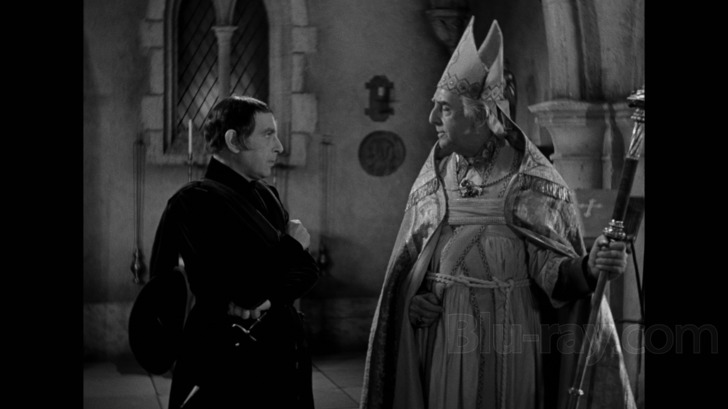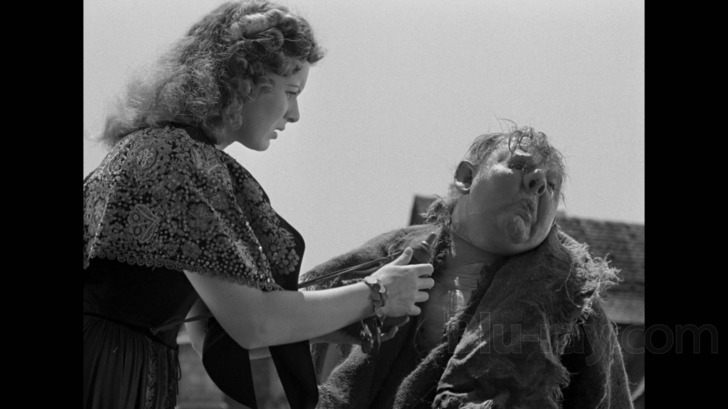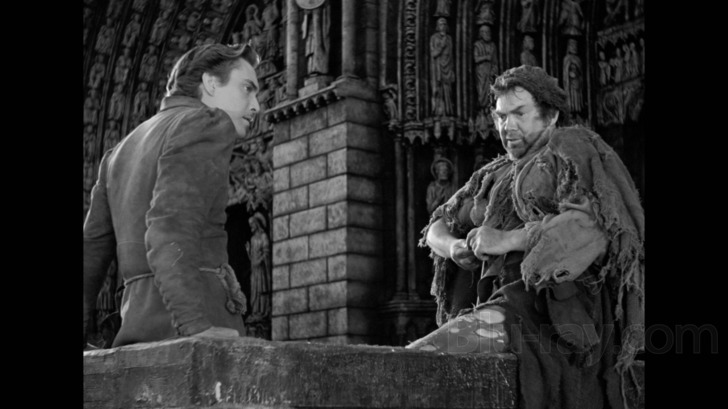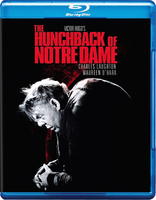The Hunchback of Notre Dame Blu-ray Movie
HomeThe Hunchback of Notre Dame Blu-ray Movie 
Warner Bros. | 1939 | 117 min | Not rated | Jun 09, 2015Movie rating
7.9 | / 10 |
Blu-ray rating
| Users | 4.0 | |
| Reviewer | 4.0 | |
| Overall | 4.0 |
Overview
The Hunchback of Notre Dame (1939)
Quasimodo, the mocked and vilified bellringer of Notre Dame, rescues the gypsy Esmeralda from hanging, sweeping all of Paris into a fight for justice.
Starring: Charles Laughton, Cedric Hardwicke, Thomas Mitchell (I), Maureen O'Hara, Edmond O'BrienDirector: William Dieterle
| Romance | Uncertain |
| Period | Uncertain |
| Drama | Uncertain |
Specifications
Video
Video codec: MPEG-4 AVC
Video resolution: 1080p
Aspect ratio: 1.37:1
Original aspect ratio: 1.37:1
Audio
English: DTS-HD Master Audio Mono (48kHz, 24-bit)
Spanish: Dolby Digital Mono
German: Dolby Digital Mono
Subtitles
English SDH, French, German SDH, Spanish
Discs
50GB Blu-ray Disc
Single disc (1 BD)
Playback
Region A, B (C untested)
Review
Rating summary
| Movie | 4.5 | |
| Video | 4.5 | |
| Audio | 4.0 | |
| Extras | 2.0 | |
| Overall | 4.0 |
The Hunchback of Notre Dame Blu-ray Movie Review
Whipping Boy
Reviewed by Michael Reuben June 12, 2015Victor Hugo's 1831 novel about the deformed bell-ringer who lives in the tower of Notre Dame Cathedral has been adapted for film and television over a dozen times, including the 1996 animated feature by Disney, but two versions remain iconic. The first is the 1923 silent classic starring Lon Chaney, the "man of a thousand faces". The second, and arguably more famous, is the remake released in 1939 by RKO Radio Pictures, which aspired to outdo Chaney's version in every respect, not just with sound but also with scale. To play the grotesque title character, whose name, Quasimodo, is familiar even to people who have never seen any of the films, Charles Laughton endured hours of daily makeup and wore layers of latex and other paraphernalia during one of the hottest summers then recorded to create an enduring image of unimaginable suffering. His efforts were rewarded with stellar reviews and equally impressive box office. With a budget of over $1.8 million—an enormous sum at the time—the 1939 Hunchback was one of the most expensive films from RKO to date. (Citizen Kane, released by the studio two years later, cost less than half as much.) The production recreated 15th Century Paris on RKO's ranch in the San Fernando Valley. Its simulation of the famous cathedral stood 190 feet tall, complete with gargoyles and stained glass windows. Hundreds of extras were recruited to populate the streets, and producer Pandro S. Berman, for whom Hunchback was a passion project, recruited director William Dieterle (The Life of Emile Zola), because of his renowned ability to sculpt crowds for the camera. At Charles Laughton's insistence, RKO borrowed British makeup expert Perc Westmore from Warner to oversee the hunchback makeup. Warner, which now owns the RKO library, is releasing The Hunchback of Notre Dame on Blu-ray both singly and as part of The Golden Year Collection—1939. While the negatives for many RKO films have been lost, Hunchback is one for which the original camera negative exists. Warner's MPI facility has performed a new scan, with stunning results.

Most adaptations of Victor Hugo's novel tone down its starkly tragic ending, but both the 1923 silent film and the 1939 RKO version take the additional step of "softening" the villain, who, in Hugo's story, is the Archdeacon of Paris and, nominally, the protector of Quasimodo. Old Hollywood did not expect its audience to accept ecclesiastic dignataries as villains (and indeed, the Production Code would have prohibited it). So the Archdeacon (Walter Hampden) became a gentle and saintly figure, while the wicked deeds he committed in Hugo's novel were handed off to his younger brother, Frollo (Cedric Hardwick), who in this film, is the Chief Justice of Paris appointed by King Louis XI (Harry Davenport). As the film opens, Frollo and the King are visiting the establishment of a printer (Charles Halton), who has just acquired the latest technological marvel: a printing press. The King is fascinated by the device's potential, but Frollo urges that it be destroyed, lest the people become too knowledgeable and rebel against their betters. Another of Frollo's concerns is immigration. The city is becoming crowded with undesirables, especially gypsies, whom Frollo holds in particular contempt. When the King's guards are ordered to bar such people from entering, a young gypsy woman, Esmeralda (Maureen O'Hara, in her first American film), slips past the gate to earn money with her dancing. She also hopes to petition the King to lift the ban on her people. Esmeralda's beauty captures the eye of many men, including the handsome soldier Phoebus (Alan Marshal), a passionate street poet named Gringoire (Edmond O'Brien), and Frollo himself. In a fateful moment, Esmeralda is also observed by Quasimodo (Laughton), the misshapen bell-ringer of Notre Dame, who has snuck away from his post, against the advice of his patrons, the Archdeacon and Frollo, to watch the street shows where Esmeralda is performing. Discovered by the crowd, the unfortunate outcast is crowned "King of Fools", but because he is deaf from years of bell-ringing, he does not at first understand that he is being mocked. As is often the case in Victor Hugo's tales, the poor and downtrodden pay the price for the sins of the rich and powerful. Here, Quasimodo is publicly lashed, and Esmeralda is sentenced to hang, all due to the machinations of Frollo. The chief justice even conspires to have the cathedral's status as a sanctuary revoked, so that Esmeralda can no longer remain there safely under Quasimodo's watchful eye. But Hugo was too worldly and realistic to paint the Parisian masses as gentle saints, and neither does the film. The crowds that hound Quasimodo are merciless, and when the poet Gringoire stumbles into the beggars' society ruled by Clopin (Thomas Mitchell), he finds an equally merciless and greedy den of thieves, swindlers and killers—although, as Clopin says in their defense, they've been driven to these extremes by necessity, and their crimes are dwarfed by those of the nobility. (Frollo's evil behavior confirms his point.) In one of the film's most famous scenes, Clopin leads the beggars of Paris in an assault on Notre Dame Cathedral, only to be repelled by Quasimodo with planks, chunks of stone and molten metal rained down from above. The irony is that both those storming the building and the lone figure defending it share the same goal, which is to protect Esmeralda. That she is ultimately saved, and Frollo defeated, brings no comfort to the gypsy girl's lonely protector. He remains a sad and isolated figure, looking out over Paris from high atop his bell tower, hearing only his bells and occasionally speaking to the stony gargoyles sitting next to him. Although Hunchback isn't a silent movie, Laughton's performance is primarily physical. He has few lines, and most of them are short; some are just a single word repeated ("Water!" "Sanctuary!"). But he conveys great pathos just in the way he lifts and drops his head, keeps his distance from people, quails before Frollo (who is supposedly his protector), shyly approaches Esmeralda and generally conducts every interaction like a creature who does not believe he is entitled to be treated as human. In a different season, Laughton's performance would have been Oscar-nominated, along with many other aspects of the film, but in the crowded field of 1939, only the score and sound were acknowledged (and neither won).
The Hunchback of Notre Dame Blu-ray Movie, Video Quality 

Venerable cinematographer Joseph H. August shot The Hunchback of Notre Dame in the same year that he also shot Gunga Din for RKO. Warner's MPI facility has created a new transfer for this release, using the original nitrate camera negative. I have been advised that several portions of the negative had deteriorated past the point where restoration was possible, and for those sections of the film, a second-generation source (probably a fine-grain master positive) was used. However, specific scenes were not identified, and it certainly was not obvious in viewing that any particular scene or shot suffered a falloff in quality. The 1080p, AVC-encoded Blu-ray is the jewel in the crown of the new titles issued by Warner for The Golden Year Collection— 1939. The detail of the lavish Paris re-creation is superb, as is that of the numerous crowd scenes, whether the mass of extras are seen in long shots from the top of the Notre Dame Cathedral tower or at closer range on the street or in the huge set that serves as the beggars' headquarters. The chaos of the scene in which the beggars storm the cathedral has never been more clearly reproduced, even with the effects, some of them created optically, required to show Quasimodo's repelling of the crowd. The elaborate Festival of Fools where Esmeralda dances and Quasimodo is "crowned" are stunning in their clarity, and the night scenes where Quasimodo chases Esmeralda through the streets of Paris feature deep blacks and precise shadows. Contrast and delineations of gray are excellent throughout. The grain pattern is fine, natural and film-like. Of the new 1939 titles, this is the only one that Warner has mastered on a BD-50, and the average bitrate of 32.90 Mbps reflects the availability of greater space, as well as the willingness to use it. This is the approach usually taken by the Warner Archive Collection, and one can only hope that it is a sign of things to come, because the results are excellent.
The Hunchback of Notre Dame Blu-ray Movie, Audio Quality 

The Hunchback of Notre Dame's original mono soundtrack is encoded as lossless DTS-HD MA 1.0, and it's very good. The sounds of Paris street life, the printer's shop, the halls of justice, the beggars' convention, Quasimodo's hideous public whipping and, most important, the clang of his sonorous "friends", the bells in the tower, are effectively reproduced, even if the dynamic range doesn't have the breadth of a contemporary recording. Alfred Newman's classical score lends a kind of melodramatic dignity to the proceedings.
The Hunchback of Notre Dame Blu-ray Movie, Special Features and Extras 

Warner released The Hunchback of Notre Dame on DVD in 1997 with a behind-the-scenes documentary, an interview with Maureen O'Hara and a trailer. The interview and trailer have been included on Blu-ray but not the documentary. Instead, there is a vintage Warner cartoon and an MGM short, both from 1939.
- Interview with Maureen O'Hara (480i; 1.33:1; 12:09): The title is somewhat misleading, as only part of this extra is devoted to interviewing the film's co-star. Much of the running time is devoted to an overview of Hunchback's production and release.
- Drunk Driving (480i; 1.37:1; 21:27): Part of the MGM "Crime Does Not Pay" series, this short dramatizes a tragic case of what we now call "DUI".
- The Lone Stranger and Porky (480i; 1.37:1; 7:26): The title of this Looney Tune is self-explanatory.
- Theatrical Trailer (480i; 1.37:1; 1:50): "See the storming of Notre Dame! See the face of the Hunchback!"
The Hunchback of Notre Dame Blu-ray Movie, Overall Score and Recommendation 

RKO issued The Hunchback of Notre Dame as a year-end holiday release but received complaints from patrons at Radio City Music Hall that it was a horror film, not a family picture. The reaction is understandable for the times, but by any standard, Hunchback does not belong in the horror genre. Quasimodo may be a sad and pitiful outcast like Frankenstein's monster, but he never poses any danger to anyone. The dangers come from other people, who cannot see past Quasimodo's distorted exterior to the childlike innocence within, as Esmeralda eventually does. Charles Laughton's ability to project that quality throughout every inch of his frame, even shrouded in specialty makeup appliances, is a triumph of screen acting and one of the many reasons why the 1939 Hunchback remains a classic. Highly recommended.
Similar titles
Similar titles you might also like

The Razor's Edge
Fox Studio Classics
1946

Madame Bovary
2014

The Last Time I Saw Paris
Warner Archive Collection
1954

Madame Bovary
Warner Archive Collection
1949

A Little Chaos
2014

Cyrano de Bergerac
1950

Revolutionary Road
2008

Camille
Warner Archive Collection
1936

Romeo and Juliet
1954

Ophelia
2018

Bel Ami
2012

Romeo and Juliet
1968

Hamlet
1990

One Day
2011

Monster's Ball
2001

Arch of Triumph
1948

All This, And Heaven Too
1940

The Other Boleyn Girl
2008

Intermezzo: A Love Story
1939

Some Came Running
Warner Archive Collection
1958
